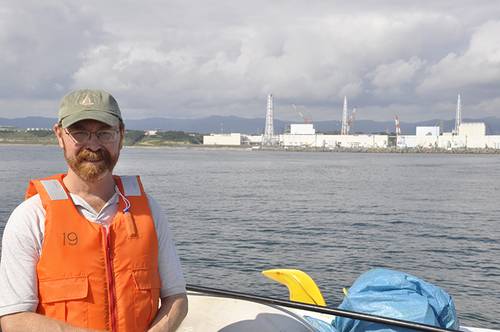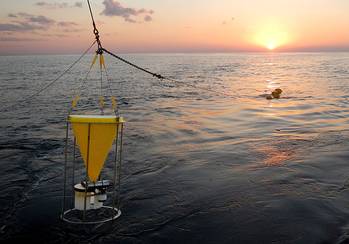Examining the Fate of Fukushima Contaminants
Posted by Eric Haun
Tuesday, August 18, 2015, 10:28 AM
Researchers deployed time-series sediment traps 115 kilometers
southeast of the nuclear power plant at depths of 500 meters and 1,000
meters. The two traps began collecting samples on July 19, 2011—130 days
after the March 11 earthquake and tsunami—and were recovered and reset
annually. (Makio Honda, Japan Agency for Marine-Earth Science and
Technology)
A fraction of buried, ocean sediment uncovered by typhoons, carried offshore by currents
An international research team reports results of a three-year
study of sediment samples collected offshore from the Fukushima Daiichi
Nuclear Power Plant in a new paper published August 18, 2015, in the
American Chemical Society's journal, Environmental Science and
Technology.
The research aids in understanding what happens to Fukushima
contaminants after they are buried on the seafloor off coastal Japan.
Led by Ken Buesseler, a senior scientist and marine chemist at the
Woods Hole Oceanographic Institution (WHOI), the team found that a small
fraction of contaminated seafloor sediments off Fukushima are moved
offshore by typhoons that resuspend radioactive particles in the water,
which then travel laterally with southeasterly currents into the Pacific
Ocean.
"Cesium is one of the dominant radionuclides that was released in
unprecedented amounts with contaminated water from Japan's Fukushima
Daiichi nuclear power plant following the March 11, 2011, earthquake and
tsunami," Buesseler said. "A little over 99 percent of it moved with
the water offshore, but a very small fraction—less than one
percent—ended up on the sea floor as buried sediment."
"We've been looking at the fate of that buried sediment on the
continental shelf and tracking how much of that contaminated sediment
gets offshore through re-suspension from the ocean bottom," he added.
The research team, which included colleagues from the Japan Agency
for Marine-Earth Science and Technology and the Japan Atomic Energy
Agency, analyzed three years’ worth of data collected from time-series
sediment traps.
Researchers deployed the preprogrammed, funnel-shaped instruments
115 kilometers southeast of the nuclear power plant at depths of 500
meters and 1,000 meters. The two traps began collecting samples on July
19, 2011—130 days after the March 11 earthquake and tsunami—and were
recovered and reset annually.
After analyzing the data, researchers found radiocesium from the
Fukushima Daiichi Nuclear Power Plant accident in the sediment samples
along with a high fraction of clay material, which is characteristic of
shelf and slope sediments suggesting a near shore source.
"This was a bit of a surprise because when we think of sediment in
the ocean, we think of it as sinking vertically, originating from
someplace above. But what this study clearly shows is that the only
place that the material in our sediment traps could have come from was
the continental shelf and slope buried nearshore. We know this because
the coastal sediments from the shelf have a unique Fukushima radioactive
and mineral signal," Buesseler said.
The data also revealed that peak movements of the sediments with
radiocesium coincided with passing typhoons which likely triggered the
resuspension of coastal sediments. Radiocesium was still detected in
sediment samples from July 2014.
"The total transport is small, though it is readily detectable. One
percent or less of the contaminated sediment that's moving offshore
every year means things aren't going to change very fast," Buesseler
said. "What's buried is going to stay buried for decades to come. And
that's what may be contributing to elevated levels of cesium in
fish—particularly bottom-dwelling fish off Japan."
While there were hundreds of different radionuclides released from
the Fukushima Daiichi Nuclear Power Plant during the disaster, after the
initial decay of contaminants with half lives (the time it takes for
one half of a given amount of radionuclide to decay) less than days to
weeks, much of the attention has remained focused on cesium-137 and-134—
two of the more abundant contaminants. Cesium-134 has a half-life of a
little over two years, and so any found in the ocean could come only
from the reactors at Fukushima. Cesium-137 has a half-life of roughly 30
years and is also known to have entered the Pacific as a result of
aboveground nuclear weapons tests in the 1950s and ’60s, providing a
benchmark against which to measure any additional releases from the
reactors.
In October, Buesseler and the research team will return to Japan to
redeploy more sediment traps. The continued study will help estimate
how long it takes to decrease the level of radiocesium in seafloor
sediments near the Fukushima Daiichi Nuclear Power Plant.
The research was funded initially by a Rapid Response Grant from
the National Science Foundation, and continued for three years through
support from the Deerbook Charitable Trust and Gordon and Betty Moore
Foundation.
-
 WHOI marine chemist Ken Buesseler, pictured on a research vessel off the coast of Japan in 2013, has been tracking the spread of radionuclides released from Fukushima since 2011. In October, Buesseler and the research team will return to Japan to redeploy more sediment traps. (Photo courtesy of Ken Buesseler)
WHOI marine chemist Ken Buesseler, pictured on a research vessel off the coast of Japan in 2013, has been tracking the spread of radionuclides released from Fukushima since 2011. In October, Buesseler and the research team will return to Japan to redeploy more sediment traps. (Photo courtesy of Ken Buesseler)
